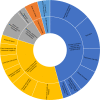A scoping review of adoption of climate-resilient crops by small-scale producers in low- and middle-income countries
- PMID: 33051616
- PMCID: PMC7553851
- DOI: 10.1038/s41477-020-00783-z
A scoping review of adoption of climate-resilient crops by small-scale producers in low- and middle-income countries
Abstract
Climate-resilient crops and crop varieties have been recommended as a way for farmers to cope with or adapt to climate change, but despite the apparent benefits, rates of adoption by smallholder farmers are highly variable. Here we present a scoping review, using PRISMA-P (Preferred Reporting Items for Systematic review and Meta-Analysis Protocols), examining the conditions that have led to the adoption of climate-resilient crops over the past 30 years in lower- and middle-income countries. The descriptive analysis performed on 202 papers shows that small-scale producers adopted climate-resilient crops and varieties to cope with abiotic stresses such as drought, heat, flooding and salinity. The most prevalent trait in our dataset was drought tolerance, followed by water-use efficiency. Our analysis found that the most important determinants of adoption of climate-resilient crops were the availability and effectiveness of extension services and outreach, followed by education levels of heads of households, farmers' access to inputs-especially seeds and fertilizers-and socio-economic status of farming families. About 53% of studies reported that social differences such as sex, age, marital status and ethnicity affected the adoption of varieties or crops as climate change-adaptation strategies. On the basis of the collected evidence, this study presents a series of pathways and interventions that could contribute to higher adoption rates of climate-resilient crops and reduce dis-adoption.
Conflict of interest statement
The authors declare no competing interests.
Figures










References
-
- Jain M, Naeem S, Orlove B, Modi V, DeFries RS. Understanding the causes and consequences of differential decision-making in adaptation research: adapting to a delayed monsoon onset in Gujarat, India. Glob. Environ. Change. 2015;31:98–109.
-
- Smith, S. M. Food Crisis in the Horn of Africa: Progress Report, July 2011–July 2012 (Oxfam International, 2012).
-
- Dhankher OP, Foyer CH. Climate resilient crops for improving global food security and safety. Plant Cell Environ. 2018;41:877–884. - PubMed
-
- Gollin D, Morris M, Byerlee D. Technology adoption in intensive post-green revolution systems. Am. J. Agric. Econ. 2005;87:1310–1316.
-
- Lin BB. Resilience in agriculture through crop diversification: adaptive management for environmental change. BioScience. 2011;61:183–193.
Publication types
MeSH terms
LinkOut - more resources
Full Text Sources
Medical
Miscellaneous

